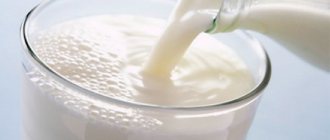Milk contains substances necessary for the human body. Therefore, it is important to store it correctly to ensure the body’s full development and protection from diseases when consumed. The debate about the benefits of this product for people of different ages continues to this day. There is no clear answer yet. Unfortunately, dairy products spoil quickly. To keep it fresh longer, you should take into account expiration dates, store milk correctly at home, and observe the length of time the natural product remains frozen.
In a refrigerator
The storage duration according to GOST and SanPiN is influenced by many factors:
- methods of primary processing of dairy raw materials,
- container,
- temperature regime,
- humidity,
- transportation conditions.
The humidity level should be 85-90%, and the optimal temperature should be in the range from 0 to +10 °C, depending on the type of product. Most products have short lead times due to the high risk of proliferation and exposure to various bacteria.
Pasteurized
This variety is most often found in stores. Pasteurization involves heating the liquid for a long time to 60 °C. As a result of heat treatment, pathogenic microorganisms die, while beneficial microflora and organoleptic properties are preserved.
Pasteurization at the enterprise allows you to increase the sales time to 2-3 weeks. Can be stored in vacuum packaging until the expiration date. If the seal has been broken, the container must be tightly closed and the contents consumed within 48 hours.
It is recommended to place packaged pasteurized milk on the third shelf or in the freshness zone.
UHT
Ultra-pasteurized is a milk product that has undergone heat treatment with short-term heating to 150°C and subsequent cooling to 5°C. In this case, some of the beneficial microelements are destroyed.
The shelf life of such a product is considered relatively long, it is set by the manufacturer and reaches six months, depending on the presence of various stabilizers, preservatives, and thickeners in the composition.
It can be safely placed on the refrigerator door or top shelves and stored until the date indicated on the package. It is not recommended to pour into another container and expose to sunlight.
Boiled
Boiled drinking milk retains its quality for 7 days.
Dishes that are planned to contain liquid must be pre-sterilized. Be sure to boil any product purchased from strangers. Remember that the usefulness of such a drink is significantly lower, since prolonged exposure to high temperatures destroys not only pathogens, but also protein, vitamins C and D, and makes phosphorus and calcium poorly absorbed.
Homemade
Village farm milk products are considered environmentally friendly and more valuable compared to factory-made ones.
Unfortunately, it quickly loses its freshness, so the maximum shelf life in a refrigerator is 48 hours.
It is recommended to pour into a clean jug or jar and close the lid.
Ghee
The origin of baked milk has Slavic roots. Preparation of the drink involves boiling and subsequent long, even simmering.
Does not sour longer than sterilized, can be stored in a refrigerator for up to 7-10 days.
Goat
Goat milk is less likely to cause skin and food reactions, which is why it is so loved by allergy sufferers. The unique composition is rich in important microelements and vitamins.
A fresh product that has not undergone heat treatment will last in the refrigerator for about 3 days if placed in a sterile and airtight container.
Once opened, a store-bought product will retain its beneficial properties for a week. Repeated boiling is prohibited.
Lactose-free
Lactose-free is produced using special technologies for removing or hydrolyzing lactose. Ideal for diabetics and people with lactose intolerance.
At temperatures from 0 to +6°C, opened packaging is stored for 3-4 days, closed – no more than 30 days.
Concentrated
Concentrated is the result of partial dehydration and sterilization (preservation) of raw milk. Used in cooking for making soups, sauces, desserts and baked goods. Ideal for hiking and living in the wild.
The products are easy to store, the recommended temperature varies up to +10 – 20 °C depending on the container, the storage period is 3 years.
Condensed
The shelf life of condensed milk is the same as that of concentrated products (2-3 years).
Sukhoi
Powdered milk is a soluble powder obtained after condensation and drying of raw materials. It is used for preparing various dishes, including food in kindergartens.
Low fat preserves its taste for 3 years and whole dry for 10 months. Store the diluted solution for no more than 72 hours.
Vegetable
Plant-based milk products are prepared from nuts, plant seeds, and cereals. The most famous varieties are coconut, almond, sesame, poppy, pumpkin, cedar, oat, rice, and soy milk.
Keep in the refrigerator for no more than 3 days.
Chest
According to the website of the Association of Natural Feeding Consultants (AKEB), fresh breast milk for a baby is stored from 72 hours to 8 days.
The longer it is in the refrigerator, the less vitamins and antioxidants remain in it. It is recommended to pour into a tightly closed bottle to prevent the absorption of foreign odors and to note the date and time of pumping.
How to prolong the freshness of milk
The packaging indicates a specific expiration date for cow's milk prepared using the “conveyor method”. To extend it means to violate the storage rules. The manufacturer independently regulates the time, which depends not only on the processing methods, but also on the introduction of thickeners, preservatives and stabilizers into the drink. Then he approves all indicators in Rospotrebnadzor.
As for natural milk, it can be stored for a day in the refrigerator. This is a very short period of time, during which the owner does not always have time to use it. The shelf life is extended by boiling or freezing.
The boiling method has one important point: the milk must be brought to a boil, but not boiled. This will allow you to preserve the useful composition as much as possible and extend the storage time. Another way to store fresh milk for a long time is freezing. Frozen “cow drink” can be stored for up to 2 months.
Often, when boiling, milk “runs away”, overflowing. To avoid this, you need to place an inverted saucer on the bottom of the pan. Another option is to use a “milk guard” (a ribbed circle with a spout).
In the freezer
If you want to keep your drink fresh longer, freezing will help. You can store it in the freezer in:
- Vacuum bags.
- Small plastic jars.
- Forms for ice (later used to add to coffee).
Initially, you should pour a little liquid from the container in which you plan to freeze the product. This is necessary because the contents expand and can damage the plastic. For breastfeeding, you need to prepare special containers or bags with a zipper (chicco, medela, Tommee Tippee).
Frozen storage time is 4 months.
Do not heat in a microwave oven or re-freeze. To defrost, place on refrigerator shelf until thawed.
Useful properties and contraindications
The popularity of milk as a food product is associated with its positive effect on the human body.
Main advantages:
- It is a natural source of digestible calcium. Improves the condition of hair and nails, strengthens bones.
- Promotes healthy sleep and calms the nervous system.
- Helps in the fight against colds and strengthens the immune system.
- Reduces the risk of cancer and diabetes.
- Fights hunger and can be used in diets and healthy eating.
- It has a positive effect on the functioning of the gastrointestinal tract, recommended for heartburn, gastritis and ulcers.
- Beneficial for children's bodies.
Despite its positive qualities, the product can negatively affect a person. It is contraindicated for people with a deficiency of lactase, an enzyme that breaks down milk sugar, as it leads to stomach upset.
Milk can cause allergic reactions. It should not be used by patients with deposits in the vessels and the presence of kidney stones.
At room temperature
At home, at room temperature, you should not leave it open for longer than 6-10 hours, as this will lead to gradual souring.
Outside the refrigerator should be placed in a dark, cool place away from the radiator and other heating elements.
Condensed, concentrated and powdered milk can be stored at +20°C for several months.
Goat milk: fresh, boiled, frozen
Goat meat is stored in exactly the same way as cow meat, only the timing differs:
- at high temperatures – 4-6 hours;
- at room temperature – 24 hours;
- at low temperature, in the refrigerator - no more than 3 days.
You can boil goat milk. And the mechanism is exactly the same as for a cow's. You can freeze it too. But it can be stored frozen much longer – up to a year.
Goat milk is not only healthier, but also safer than cow milk, since the goat does not suffer from tuberculosis and brucellosis
Depending on the container
Plastic bag
Soft packaging (fin-pack, berta-pack) has a low cost and is usually used for pasteurized dairy products (Pestravka, Piskarevskoe). This is a film made of high-strength polyethylene, dense and grease-resistant, protecting from exposure to sunlight.
The shelf life is 3 weeks.
Plastic bottle
The product in a plastic bottle (Kubanskaya Burenka, Selo Zelenoe, Vkusnoteevo, Little House in the Village, Vesyliy Milkman, Prostokvashino) has a short shelf life (up to 3 weeks) due to lower tightness compared to a tetra bag and the risk of exposure to sunlight.
Can
The tin can (Shadrinskoe) is practical.
Allows canned contents to be stored for several years.
May give a slight metallic taste.
Tetrapack
Tetrapak (Bezhin Lug, Parmalat, Agusha, Frutonyanya, Semenishna, Yasny Lug) allows you to preserve the taste and is easy to use. Typically, UHT milk is produced in a box, requiring aseptic filling, which is what this type of material provides.
The product is good for an average of six months.
Glass
Glass was actively used during the Soviet era, but is now rarely found: mainly for premium and children's products (EtoLeto, Rogachev, Mozhaiskoye). It is easy to damage, and when exposed to sunlight, vitamin C is destroyed very quickly. It preserves the taste of dairy products best of all.
In such packaging, the contents have a short shelf life of 36 hours.
Legal requirements
The period of time after which a food product cannot be eaten, even if all storage conditions are met, is called the expiration date. It guarantees that if the product was stored correctly, it will not cause any harm to health during this period.
There is another period - storage. It is less than the expiration date. During this period, the product retains the same qualities that were inherent in it immediately after production.
On June 16, 1997, the Government of the Russian Federation adopted Resolution No. 720 listing goods that cannot be used after the expiration date. Accordingly, this information must be printed on consumer packaging.
The section “Dairy Products” contains such items as cow’s milk, baked milk, and whole milk products. Therefore, the manufacturer is obliged to put expiration dates on the packaging. Due to the inclusion of this product in the list of Decree No. 720, it cannot be eaten unless the expiration date is indicated.
Based on Article 473 of the Civil Code of the Russian Federation, this period begins from the date of production. For example, if a product was produced on the 19th and its expiration date is 5 days, then the end date of the period will be the 23rd.
Determining the delay
In order not to purchase expired goods in a supermarket, market or from hand, adhere to the following rules:
- There should be no unpleasant or strange odor (if purchased steamed or unpasteurized).
- Choose the freshest product with a recent production date (Promotions most often sell expired products).
- When buying at the market, ask the merchant for certificates, look at the sanitary conditions of the point.
- Consumer packaging must not be deformed or swollen.
- Between whole and normalized, it is preferable to choose whole selected.
Marking according to GOST
Marking on consumer packaging is applied in accordance with GOST R 51074. This document lists the information that the manufacturer applies to the packaging. Among other things, the expiration date is also indicated.
The same GOST states that if a product must be kept under certain temperature conditions, then storage conditions are also applied to the consumer packaging. Accordingly, the package (box, bottle, etc.) of milk indicates at what temperature it must be kept before and after opening.
How can you tell if milk has gone bad? What to do with sour milk?
To understand freshness, you need to check the smell, color, consistency, try boiling or look at the reaction of milk and baking soda.
- Checking for an unpleasant odor is the first thing that might come to mind. Sour milk gives off an unpleasant aroma, while fresh milk does not smell of anything.
- There should be no clots in fresh milk ; it is a light liquid. Clots can be found in sour water.
- Spoiled milk becomes dull and has a yellow tint . Good - white.
- If, when heated, the liquid thickens, lumps appear in it that were not there, the product has turned sour.
- You can also check the suitability of milk using soda . To do this, take one teaspoon of baking soda and add a couple of drops of milk. If the soda starts to bubble, the product is clearly already spoiled. And the more bubbles, the more sour the milk.
What to do if the product's shelf life has expired? The first thing that comes to mind is to throw it away . But you don't have to do this. In fact, you can cook something yourself from sour milk.
Prepared from sour milk:
- Pancakes.
- Cottage cheese.
- Manna.
- Cocktails.
- Soups.
- Cookie.
Kinds
Today you can purchase almost any of the existing dairy products. The milk itself is presented in a large assortment. On supermarket shelves you can see not only traditional cow meat, but also goat and sheep meat. This product is also distinguished by the type of processing.
- Sterilized is a product that is heated above +100°C and boiled for several minutes. Many people do this treatment at home using regular boiling. This treatment destroys all beneficial and harmful bacteria, including lactic acid bacteria. Such a drink no longer contains useful elements, but does not change its taste, and remains suitable for consumption for quite a long time.
- Pasteurized - with this treatment the product is heated to + 60°C once. Milk of this treatment should be stored at a temperature of +3°C - +5°C for 2 - 3 days. After this time, the product will begin to sour.
- Ultra-pasteurized – a product quickly heated to +150°C and cooled just as quickly. The storage conditions for milk after such treatment are similar to those for pasteurized milk, but it will be stored longer, since all the bacteria that lead to sour milk when heated die. It must be said that the taste and beneficial qualities in such products are preserved almost completely.
GOSTs define the following types of milk:
- Whole. A product that has been strained but cannot be changed in fat content. It fully preserves the natural ratio of fats, proteins, and carbohydrates.
- Low fat. Cream is separated from such milk using a separation process. It has a taste similar to whole, but the content of fats, proteins and carbohydrates in it is reduced by 2 times. This product is used by people who watch their weight.
- Normalized. First, the products are completely degreased and the cream is separated. Then, by adding cream to the low-fat product, the required fat content is achieved. The composition is normalized so that the fat content is not too high. Cottage cheese, sour cream and other products with the required fat content are made from this milk.
- Refurbished. It is made from a powder product or milk concentrate with the addition of water.
Types of packaging
Products sold in plastic bags or cardboard bags are most often pasteurized. Pasteurized milk can be stored for no more than 3 to 5 days.
Products that have undergone ultra-pasteurization and sterilization are bottled under completely sterile conditions. After such treatment, milk is stored only in special packaging made using Tetra-Pak technology. They provide storage conditions under which the product retains all its qualities for up to six months. Ultra-pasteurized products should not be purchased in containers made of polyethylene and cardboard.
Coconut
To get a natural drink, coconut pulp is crushed and then water is added to it. Its smell and taste are neutral, but coconut milk contains a large amount of useful substances. It can be purchased in stores in cans or paper packages. In a closed container it will keep for a long time, but after opening the package it should be consumed within 1 day.
Ghee
Baked milk is almost ordinary milk, having a high concentration. It contains fats and calcium in large quantities. When heating, the milk should not boil. It is kept at +85°C - +90°C for a long time, which is why vitamins are preserved in it.
Baked milk should be stored exclusively in the refrigerator, in a tightly sealed container at a temperature not exceeding +8°C. Then it will remain fresh for about a week.











